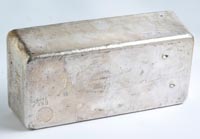
|
Sale 62
The Pre-Long Beach Coin and Currency Auction
| Modern Commemorative Medals and Ingots |
| |
| |
| Lot |
Photo |
Description |
Realized |
Lot 1984 |
 |
U.S. Assay Office of New York 1968 1000 oz Silver Bar. .999 fine. Face displays Assay Office stamp, date and eagle. On one side is a stamp "M157" and on the other is a stamp "3".
A good account of the silver situation is given by Richard Smith in "A Modern Silver Story" at the website www.onlygold.com. The discussion is lengthy but it explains the transition from silver-backed money in America to today's problematic Fiat system:
"From 1935 through 1962, every one-dollar bill printed and placed into circulation by the Treasury had been a silver certificate, entitling the bearer to one dollar's worth of silver (.77 ounces) at the monetary standard of $1.29 per ounce. Billions of notes bearing the silver promise had been printed during that time (over 4 billion from 1957 to 1962 alone) and, even allowing that the vast majority of those had been replaced by newer issues as they wore out, there were still hundreds of millions of them in circulation.
"In 1963, the Bureau of Engraving and Printing began cranking out the new series $1 Federal Reserve notes, the first Federal Reserve issue of that denomination since 1914, in an effort to replace the older silver certificates in circulation. Yet it still remained that there were plenty of silver certificates in private hands, each bearing a promise to pay a dollar's worth of silver.
"In fact, ever since the first issuance of silver certificates in 1880, they had been, both in theory and in practice, redeemable at the Treasury's cash window for silver dollars. But, with the supply of silver dollar coins in the Treasury vaults having been drawn down from some 400 million coins in 1954 to fewer than 4 million coins by the end of 1963, on March 25, 1964, Treasury Secretary Douglas Dillon announced that silver certificates would no longer be redeemable in silver dollars, but only in silver bullion.
"And in a further effort to end the Treasury's silver dealings entirely, it was decided to set a deadline for the redemption of silver certificates into actual silver. On June 4th, 1963, Congress passed an act allowing holders of silver certificates only until June 24th, 1968 to convert them to silver. After that date, the notes would still be legal tender, but the silver clause would be moot.
"With this deadline in place, the race for redemption was on! A commercial trade sprang up in silver certificates. Newspapers across the country began running ads from dealers offering to pay $1.10 for each silver certificate, then $1.25 as silver prices rose. Notes were being purchased by aggregators, bundled, and sent to the only two facilities which were authorized to dispense silver for the notes - The U.S. Assay Offices in New York and in San Francisco.
"The Treasury Department had to honor the silver redemption clause, but they had no incentive to make it easy or convenient for citizens to convert their paper to silver. The treasury interpreted the law strictly and narrowly - a dollar's worth of silver (at the $1.29 per ounce rate) on demand.
"Small holders were given little plastic bags containing more or less pure silver grains. For transactions larger than 100 ounces or so, the Treasury poured extremely crude silver bars of fineness greater than 90% and less than 99.9%. Today we know these bars as 'grease bars' - unstamped and unrefined, these crude bars are recognizable because they have their weight written on them with a grease pencil.
"These ungainly forms of silver were the embodiment of the Treasury's attitude towards those citizens who turned in their certificates for silver - here's your silver, unmarked as to origin, weight, or fineness - in essence, as unattractive and unmarketable a product as could be legally produced.
"However, a few U.S. Assay Office bars are known from that period that were stamped as to fineness and origin. These bullion items were refined and configured to the specifications of 'good delivery bars'- of 99.9% purity, and weighing approximately 1,000 ounces each. Conjecture is that these refined bars were released to the largest redeemers of silver certificates.
"These bars, marked and assayed to .999 fineness, are stamped with the Eagle insignia of the U.S. Assay Office, but have no indication of weight."
Estimated Value $27,000-UP.
View details and enlarged photo
| Realized
$28,175 |
Lot 1985 |
 |
U.S. Assay Office of New York 1968 1000 oz Silver Bar. .999 fine. Face displays Assay Office stamp, date and eagle. On one side is a stamp "M157" and on the other is a stamp "4".
Estimated Value $27,000-UP.
View details and enlarged photo
| Realized
$28,175 |
Lot 1986 |
|
A large lot of Franklin Mint Sterling Silver Ingots. Consists of: 10,000 Grains (1); 1000 Grains Banks (100); 1000 Grains Ships (50). A very interesting ingot lot. Over 300 ounces of silver.
Estimated Value $6,500 - 7,000.
The Wayne Fowler Estate.
View details
| Realized
$8,395 |
Lot 1987 |
|
A large lot of Silver Medals. Consists of: 1987 1 oz pure Silver medals for Pope John Paul II (30); Franklin Mint Mother's Day Silver Medals, each in a case (5); 1963 Padre Serra Silver 35 mmm medals (19); Miscellaneous 1 oz silver medals (3). Lot of 57 coins.
Estimated Value $1,600 - 1,700.
The Wayne Fowler Estate.
View details
| Realized
$1,783 |
Lot 1988 |
|
A lot of small Silver Bars. A 4-piece lot of 2500 grain silver Presidential bars. Each bar has 5.28 oz of sterling silver. Total approximately 21 oz of Sterling Silver. Lot of 4 bars.
Estimated Value $425 - 450.
View details
| Realized
$552 |
|
|